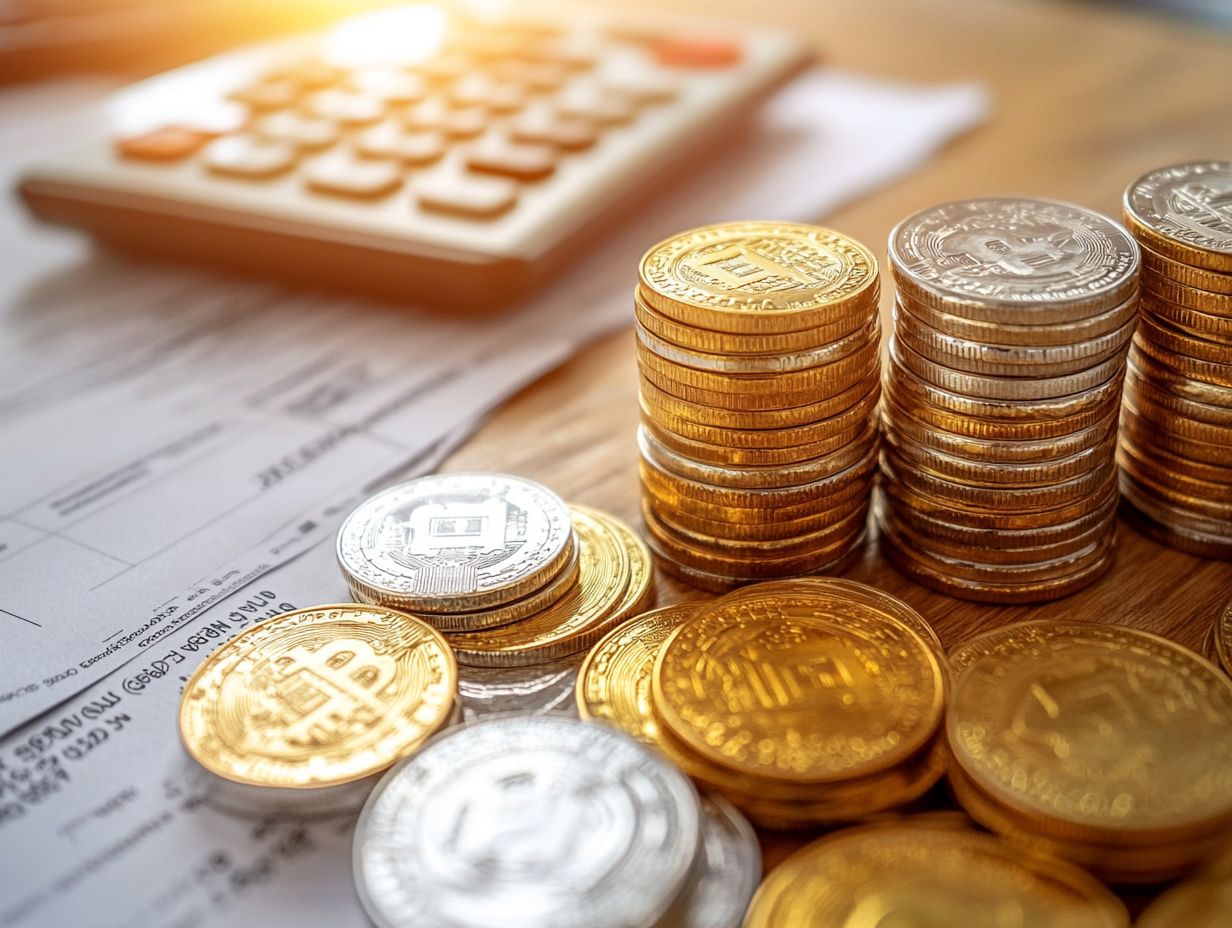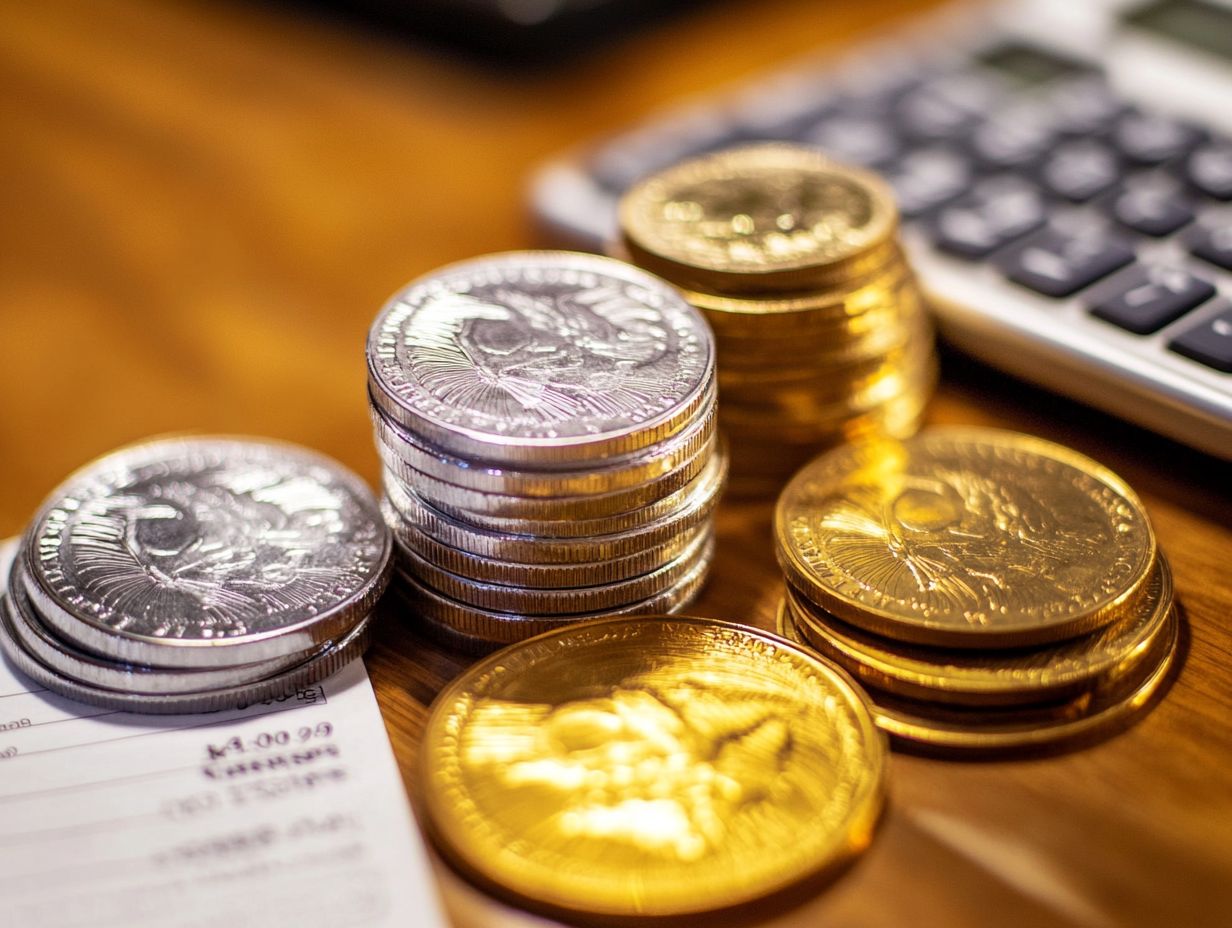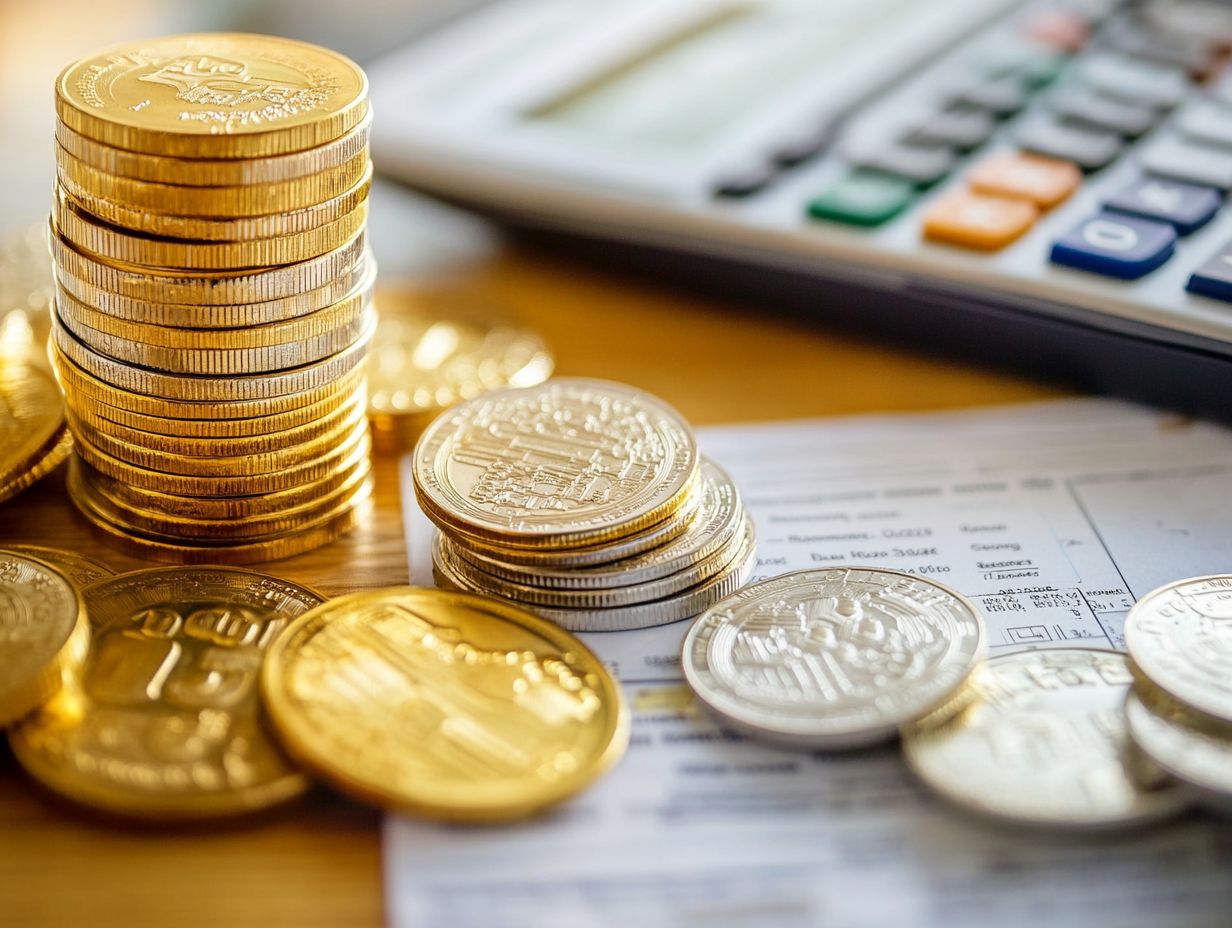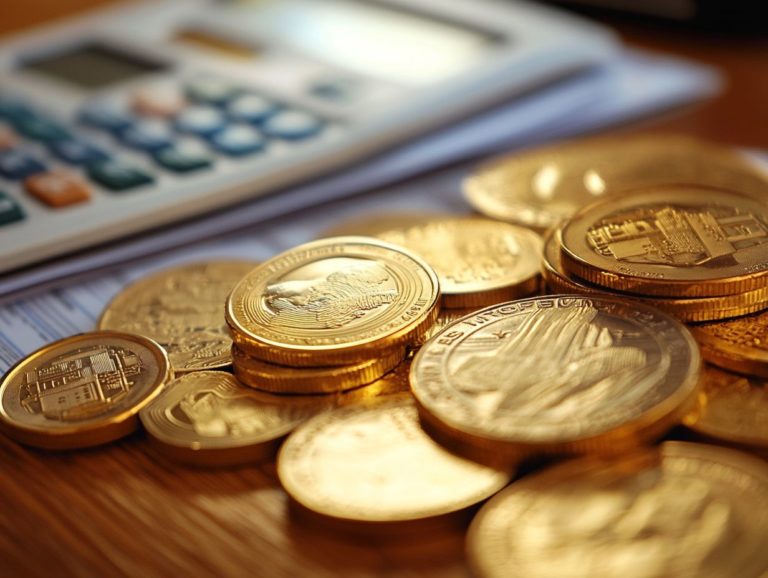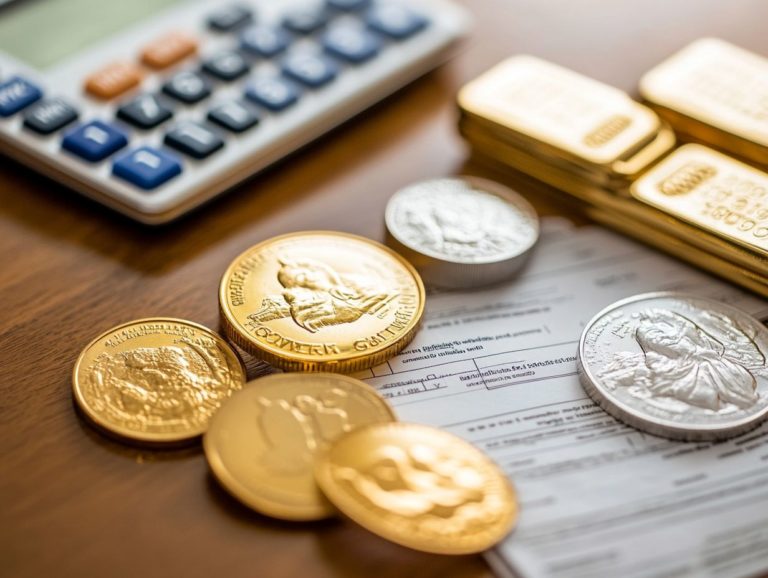Understanding the Tax Code as it Relates to Precious Metals
Investing in precious metals can be rewarding. However, understanding the tax landscape is crucial for your success.
This article details the key tax implications of buying and selling precious metals. It includes essential information on capital gains tax and reporting requirements.
You’ll learn about tax-advantaged accounts like IRAs and 401(k)s. We’ll also discuss inherited metals and your tax responsibilities.
Learn effective strategies to minimize your tax liability. This ensures you maximize the benefits of your investments.
Contents
- Key Takeaways:
- Understanding Tax Codes
- Tax Implications of Buying and Selling Precious Metals
- Tax-Advantaged Accounts for Investing in Precious Metals
- Navigating Tax Laws for Inherited Precious Metals
- Tips for Minimizing Taxes on Precious Metals
- Frequently Asked Questions
- What is the tax code for precious metals?
- What types of retirement accounts are eligible to invest in precious metals?
- Are there any restrictions on which precious metals can be invested in?
- Do I have to pay taxes on my investments in precious metals?
- What are the tax implications of selling precious metals?
- Is there a way to avoid taxes on my precious metals investments?
Key Takeaways:
- Understand tax implications when buying and selling precious metals.
- Utilize tax-advantaged accounts, like IRAs and 401(k)s, for better investment outcomes.
- Know the inheritance tax laws when inheriting precious metals; consult a tax professional for advice.
Understanding Tax Codes
Understanding the tax codes that govern investing in precious metals—like gold, silver, and platinum—is essential for anyone looking to diversify their portfolios and optimize their financial growth. The intricate regulations established by the IRS dictate how transactions involving these commodities are taxed. This influences everything from capital gains to reporting requirements.
As you navigate the complexities of capital gains tax, grasping the definitions and classifications pertaining to various investment vehicles, such as precious metals IRAs and traditional IRAs, is crucial for making informed decisions.
Tax Implications of Buying and Selling Precious Metals
Investing in precious metals entails important tax implications that you should carefully consider when buying or selling these valuable commodities. The process can introduce various tax liabilities, influenced by factors such as market value fluctuations and the length of your investment holding period.
Grasping the distinctions between short-term and long-term gains is essential for minimizing capital gains tax and aligning your investment strategies with your financial objectives, especially during periods of economic uncertainty.
Capital Gains Tax
Capital gains tax is a crucial factor for you as an investor in precious metals like physical gold, silver, and platinum. This tax applies to the profit you earn from selling these assets and varies depending on whether your gains fall into the short-term or long-term category.
Long-term gains, which come from assets held for over a year, generally enjoy more favorable tax rates than short-term gains, which can significantly influence your overall tax liability. Understanding the difference between these two types of gains is vital for anyone aiming to optimize their investment returns.
For instance, if you sell precious metals within a year of purchase, short-term capital gains will typically be taxed at ordinary income rates—often much higher than you’d like. On the flip side, long-term capital gains tax rates are usually more forgiving, leading to significant tax savings.
To accurately gauge your capital gains tax, start by determining the cost basis. This includes not just the purchase price but also any transaction fees and costs related to improving the asset. Recognizing the importance of holding periods can enable you to strategize effectively about when to sell your assets, ensuring you take full advantage of the most beneficial tax implications.
Reporting Requirements
Understanding the reporting requirements for tax purposes is essential for you as an investor in precious metals. This knowledge ensures compliance with IRS regulations and involves identifying necessary forms, such as Form 1099-B, which reports sales of precious metals and other assets that impact your tax obligations. You must remain vigilant about your reporting to avoid penalties and accurately reflect any taxable distributions from precious metals IRAs or other investment vehicles.
Maintaining comprehensive records of all transactions is crucial. These details will not only assist you in accurately completing Form 1099-B but also support valid claims for any potential tax deductions. By diligently documenting your purchase prices, sales figures, and related expenses, you can present a clear financial picture to the IRS.
Engaging tax professionals can significantly enhance your compliance efforts, providing expert guidance tailored to your unique circumstances. Their insights will help you navigate the intricate landscape of precious metals taxation, ensuring that you meet all federal mandates while maximizing your potential returns.
Tax-Advantaged Accounts for Investing in Precious Metals
Tax-advantaged accounts like precious metals IRAs, traditional IRAs, and Roth IRAs present exclusive opportunities for you as an investor looking to incorporate gold, silver, and platinum into your investment portfolio. These accounts enable you to defer taxes on capital gains, effectively optimizing your financial growth over the long term.
However, it’s essential for you to navigate the unique rules and regulations that govern these vehicles. Doing so will help you maximize your tax deferral strategies while ensuring you remain compliant with IRS guidelines.
IRA and 401(k) Options
You have a wealth of options when it comes to incorporating precious metals into your retirement savings, with IRAs and 401(k) plans standing out as two of the most favored investment vehicles. These accounts can accommodate a range of assets, including physical gold and other precious metals, potentially offering you tax exemptions and benefits that enhance your long-term financial strategy. It’s crucial to grasp the specific rules governing these accounts to optimize your investment approach.
For instance, a self-directed precious metals IRA allows you to invest in tangible commodities like silver bars and platinum coins, while traditional 401(k) plans may provide only limited exposure through gold ETFs or mutual funds. Establishing a precious metals IRA typically involves selecting an approved custodian who will manage your assets, followed by choosing eligible metals that comply with IRS criteria.
You should also keep an eye on contribution limits and potential penalties for early withdrawals, ensuring that your retirement planning aligns seamlessly with your financial objectives and regulatory requirements.
Benefits and Limitations
Investing in a precious metals IRA presents both distinct benefits and limitations that merit your careful consideration. The most prominent advantage is the potential for tax deferral on capital gains, enabling you to grow your wealth without the immediate burden of taxes.
However, there are limitations to keep in mind, such as specific reporting requirements and the possibility of higher fees, which can influence your overall investment strategy.
These factors can significantly shape how you approach your portfolio allocation. For example, while precious metals can act as a hedge against inflation and economic downturns, the stricter regulations governing these accounts might deter some investors from diving in. Additionally, the volatility of gold and silver prices makes market timing a critical factor, often leading to riskier strategies.
Striking a balance between these elements is essential for anyone considering the incorporation of precious metals into their retirement savings, ensuring that you thoughtfully weigh both the advantages and challenges.
Navigating tax laws for inherited precious metals is challenging. It’s vital to understand both inheritance tax and estate tax.
As a beneficiary of assets such as gold and silver, you must be aware of the tax obligations associated with these valuable commodities.
The IRS has laid out specific regulations pertaining to these situations. This makes it crucial for heirs like you to consult with tax professionals.
This collaboration will ensure compliance and help you maximize your financial outcomes.
Understanding Inheritance Tax and Estate Tax
Understanding the distinction between inheritance tax and estate tax is essential when you’re an heir receiving precious metals. Each tax type carries specific conditions and implications.
Inheritance tax applies to individuals who receive assets from a deceased person’s estate, while estate tax is calculated based on the total value of the estate before any distribution occurs.
Being well-informed about these tax obligations is crucial for effectively managing the financial impact of your inherited gold, silver, and platinum.
Precious metals often hold considerable value, making them significant components of an estate. The IRS has set certain thresholds; if the total estate exceeds $12.06 million (as of 2022), it may be subject to estate tax.
Keep in mind that inheritance tax rates can vary significantly depending on your state, along with exemptions that could impact your overall tax burden.
For anyone inheriting precious metals, it’s vital to remain aware of these obligations. Ensure proper valuations are conducted at the time of the deceased’s passing to avoid potential future penalties.
Tips for Minimizing Taxes on Precious Metals
Minimizing taxes on precious metals requires smart planning and a thorough understanding of the diverse tax implications at play.
You can employ various strategies to effectively reduce your tax liability, such as:
- Carefully timing your sales
- Utilizing tax-advantaged accounts
- Seeking guidance from tax professionals to navigate the intricate regulations
By proactively managing your investments in gold, silver, and platinum, you can optimize your portfolio while keeping your tax obligations to a minimum.
Strategies for Reducing Tax Liability
You can reduce your tax liability on precious metals through savvy investment strategies, including tax deferral techniques and charitable donations.
Consider utilizing a 1031 exchange, which allows you to defer capital gains taxes by reinvesting in similar assets. You can also make strategic contributions to charitable organizations for valuable tax exemptions.
These methods offer immediate tax relief while enhancing the long-term growth of your portfolio by allowing you to allocate more capital toward appreciating assets.
By deferring taxes through a 1031 exchange, you can maintain higher investment levels and facilitate greater wealth accumulation.
Charitable donations provide immediate tax deductions and align your investments with your personal values, fostering a sense of social responsibility.
Don’t miss out! Consult with financial advisors to create a winning strategy for your future by harmonizing these tax-saving tactics with your overall investment objectives.
Frequently Asked Questions
What is the tax code for precious metals?
The tax code for precious metals is under Section 408(m) of the Internal Revenue Code. This section allows certain types of retirement accounts to invest in precious metals without incurring taxes.
What types of retirement accounts are eligible to invest in precious metals?
Traditional IRAs, Roth IRAs, SEP IRAs, and Solo 401(k) plans are all eligible to invest in precious metals under the tax code.
Act now to secure your financial future by understanding your tax obligations!
Are there any restrictions on which precious metals can be invested in?
Yes, you can invest in specific precious metals. These include gold, silver, platinum, and palladium coins and bars that meet certain purity standards.
Do I have to pay taxes on my investments in precious metals?
It depends on your retirement account type and investment method. Traditional IRAs and Solo 401(k) plans may incur taxes upon distribution, while Roth IRAs and SEP IRAs often allow for tax-free withdrawals.
What are the tax implications of selling precious metals?
The tax implications vary based on your account type and age when selling. Selling outside of a retirement account might subject you to capital gains taxes.
Is there a way to avoid taxes on my precious metals investments?
Holding precious metals in a self-directed IRA could help you avoid taxes. This type of account allows for no taxes now or later, but it’s vital to follow IRS rules to avoid penalties.




